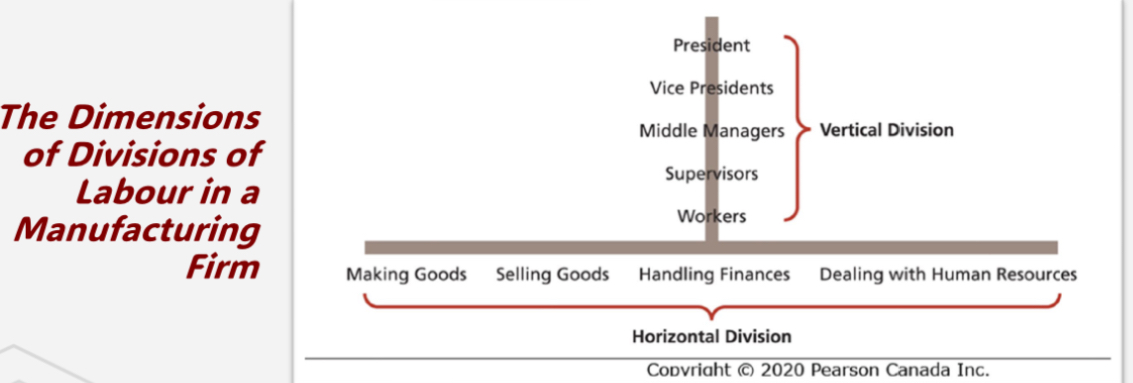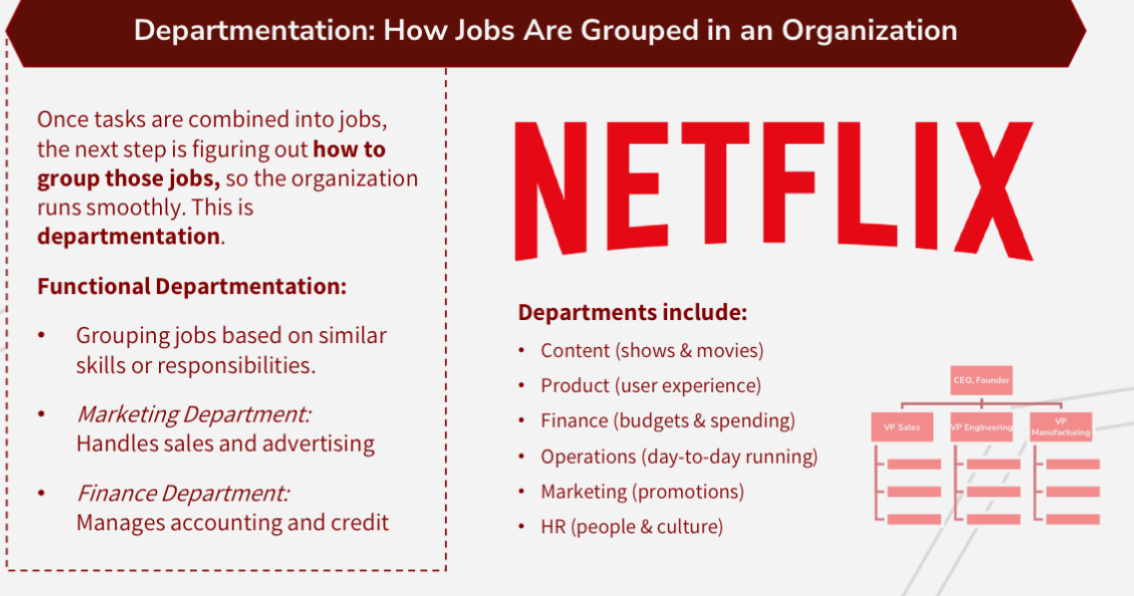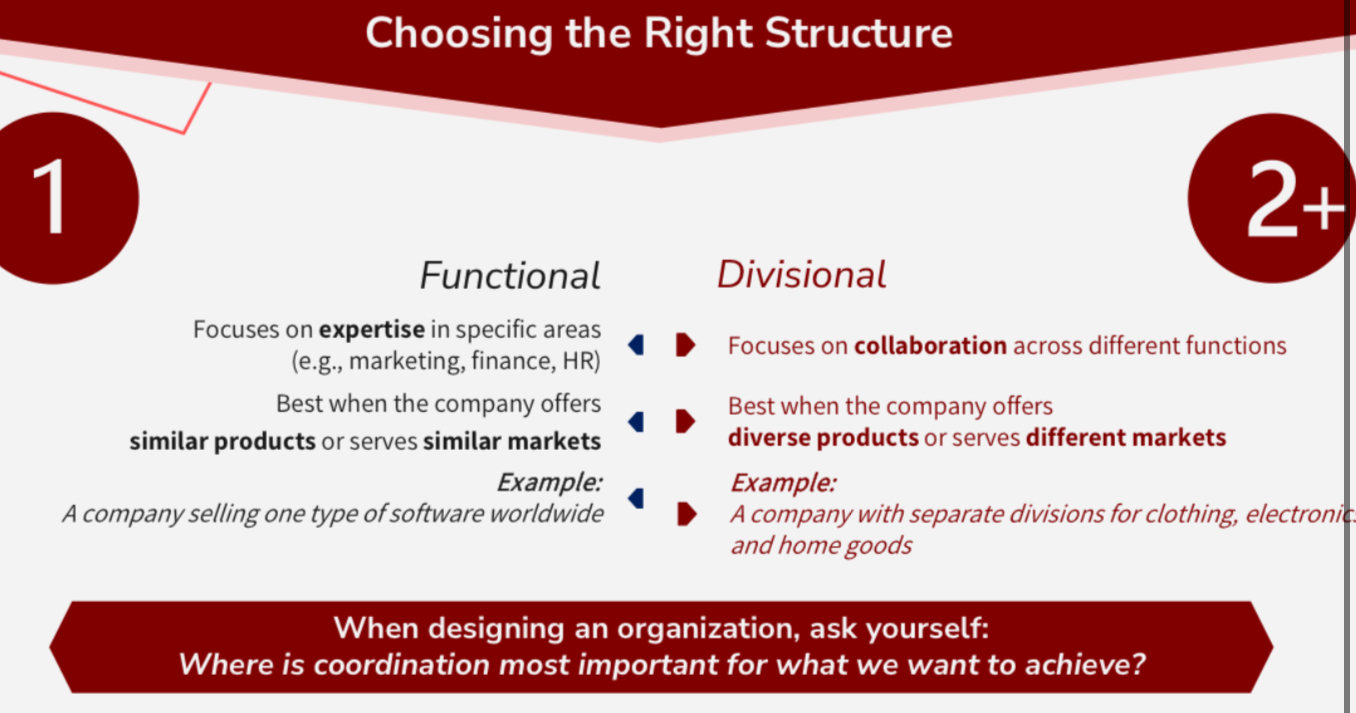Class 17: Organizational Structure
1/34
There's no tags or description
Looks like no tags are added yet.
Name | Mastery | Learn | Test | Matching | Spaced |
|---|
No study sessions yet.
35 Terms
External environment
Refers to events and conditions surrounding an organization that influence its activities
Open system concept
Sensitizes us to the need for organizations to cope with the demands of the environment on both the input side and the output side
Components of the external environment
the general economy
Customers
Suppliers
Competitors
Social/political factors
Technology
Labor supply
Environmental uncertainty
Exist is when the external environment is vague, difficult to diagnose, and unpredictable
What shapes organizational structure in 2025?
remote and hybrid work
Digital transformation and AI
Agility and speed
Diversity of products and markets
Employee experience and culture
Remote and hybrid work
Teams need to collaborate across locations and time zones
structures are more flexible and less hierarchical, with emphasis on autonomy and digital communication
Digital transformation and AI
Roles and departments now include AI specialists, data analysts, and automation engineers
cross functional teams are common to integrate tech into every part of the business
Agility and speed
Companies must respond quickly to change, so they use agile structures like project-based or squads
decision-making its often decentralized to empower faster action
Diversity of products and markets
If a company serves multiple markets or product lines, it may adopt a divisional structure to allow tailored strategies
Employee experience and culture
Organizational design now considers well-being, inclusion, and purpose
structures support collaboration, growth, and engagement, not just efficiency
Most common strategic responses
A change in organizational structure
Organizational structure
Is the manner in which an organization divides its labor into specific tasks and achieves coordination among these tasks
it’s the operating manual of the organization
Tells members how the organization is put together and how it works
Describes how members are accepted, how leadership is chosen, and how decision are made
It shapes the experiences of employees
structure affects your behaviors and the way you relate to others
Interacting with someone at Google vs at Revenue Canada
It ensures
Work is done in the best way
Each employee’s tasks contribute to the whole
Orderly deference among organizational members
Ensure that members work together harmoniously
Uncertain environments require rapid adaptation
Increased use of temporary or project-based structures
Fast-changing environments demand quick information flow
Structures may include cross-functional teams, liaison roles, or integrators to improve coordination across departments
Flexibility and speed are critica
Organizations may move away from traditional hierarchies toward modular, networked, or platform-based structures
Rigid roles can limit responsiveness
Organizations may adopt fluid or broad job scopes to allow employees to pivot as needed
What is organizational structure?
Labor must be divided because individuals have physical and intellectual limitations
There are two basic dimensions to the division of labor
a vertical dimension
A horizontal dimension
Once labor is divided, it must be coordinated to achieve organizational effectiveness

Vertical division of labor (who is in charge?)
Focuses on authority and decision-making
Defines the chain of command
Key themes
Autonomy’
Control
Communication
Focuses on authority and decision-making
Who makes the plans? Who follows them?
Defines the chain of command
A manager giving direction to a team member
Autonomy
How much freedom do employees have to make decisions?
Control
Who monitors performance and enforces rules?
Communication
How do instructions and feedback flow up and down?
Horizontal division of labor (what it mean sin real life)
Breaks down work into specific roles
Groups similar jobs into departments
Specializes people based on skills or functions
Connects to job design and the organization’s purpose
Breaks down work into specific roles
Think: splitting tasks between marketing, finance, and operations
Groups similar jobs into departments
Like how a restaurant has kitchen staff, servers, and hosts — each with a clear focus
Specializes people based on skills or functions
You would not ask a chef to manage payroll, right?
Connects to job design and the organization’s purpose
The way tasks are divided should support what the organization is trying to achieve
How can we summarize the structure of organizations?
span of control
Flat vs tall
Formalization
Centralization
Complexity
Departmentation: how jobs are grouped in an organization
One tasks are combined into jobs, the next step is figuring out how to group those jobs, so the organization runs smoothly. This is departmentation
Groupings jobs based on similar skills or responsibilities
Marketing department: handle sales and advertising
Finance department: manages accounting and credit

Functional departmentmentation
Functional structures are very efficient when we have one product, serving one market, dealing with one type of customer

Divisional departmentation
formed based on geographic market, product line etc: major dimensions of the business
Departments operate fairly independently because each have own set of functional specialists dedicated to output

Choosing the right structure
When designing an organization, ask yourself: where is coordination most important for what we want to achieve?

Functional structure
Focuses on expertise in specific areas (e.g. marketing, finance, HR)
Best when the company offers similar products or serves similar markets
Ex: a company selling one type of software worldwide
Divisional structure
Focuses on collaboration across different functions
Best when the company offers diverse products or serves different markets
Ex: a company with separate divisions for clothings, electronics, and home goods